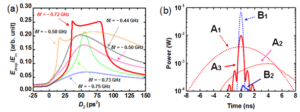Time domain measurement of high Q-value intermodal coupling
Research
Time domain measurement of high Q-value intermodal coupling
First Step to Photon Memory Realization
Coupled resonators, which are systems of micro optical resonators coupled with each other via light, have long been actively studied as devices that can serve as platforms for various applications, including slow light, sensors, and lasers. However, if the transient behavior of coupled resonators can be observed and controlled, it will open the way to "dynamic" applications such as optical buffers, optical switches, and quantum information processing. If the transient behavior of coupled resonators could be observed and controlled, it would open the way to "dynamic" applications such as optical buffers, optical switches, and quantum information processing.
Against this background, we present a study of ultrahigh-voltage in silicatroid micro-optical resonators.qValue(>107) coupling between resonance modes in the time domain. Such highqThis is the first time that coupling between resonance modes with different values has been studied in the time domain. When resonant modes are strongly coupled, optical energy is transferred back and forth between them (energy oscillation). The use of resonant modes with ultra-high Q-values increases the number of such energy oscillations, which has the advantage of facilitating observation and control. In addition, because this research uses coupling between clockwise (CW) and counter-clockwise (CCW) modes within a single resonator, the strict control of the distance between resonators and the resonant wavelength that is required in a normal coupled resonator system is not necessary, and the experiment can be performed with a simple setup. This allows experiments to be performed with a simple setup.

Fig. 1(a) Schematic illustration and master equations of the developed numerical model. (b) The calculated light energy in the CW (blue) and CCW (red) modes. The inset shows the cavity transmission spectrum (blue) and the Fourier transformed spectrum of the input pulse (green.) The parameter used for the The calculation is (kappa, gamma0, gammataperThe input signal is a rectangular pulse with a pulse width of 10 ns.
Fig. 1(a) shows the mathematical model of the experiment, with the CW mode (aCW) and CCW mode (aCCW) is the coupling ratekappaThe modes exchange energy with each other at a frequency equivalent to the frequency of the resonator. In parallel, each mode is affected by the resonator's inherent loss rategamma0and loss rate to fibergammataperThe energy is gradually lost by Therefore, the number of observable energy transfers is gamma = kappa/(gamma0 + gammataper). Theoretical energy oscillation waveforms calculated from the model are shown in Fig. 1(b), where the energy in the CW and CW modes alternately oscillate and decay. In this study, the ultra-highqvalue mode was used.gamma0andgammataperbecomes smaller andgammaA large value of ~13 was achieved.

Fig. 2(a) Schematic illustration of the experimental setup where the two tapered fibers are employed. (b) The experimental result of the observation of the energy oscillation between the CW (blue) and CCW (red) modes. Note that the timings of the CW and CCW signals were calibrated by measuring the delays between the two signals. Note that the timings of the CW and CCW signals were calibrated by measuring the delays between the two signals.
Fig. 2(a) shows a schematic diagram of the experiment. Fig. 2(b) shows the experimental results. The result shows that the energy in the CW mode (blue solid line) and the energy in the CCW mode (red solid line) oscillate alternately. The period of the energy oscillation and the speed of decay are in extremely high accuracy with those calculated from the frequency-domain measurements, and thus the oscillation is considered to be an ultrahighqWe can conclude that this is due to the coupling between the CW and CCW modes. This result is consistent with the results obtained for ultra-highqThis is a first step toward dynamic control of the coupling between value resonators.
- Categories
- 研究トピックス



